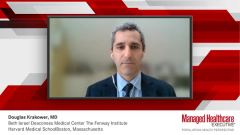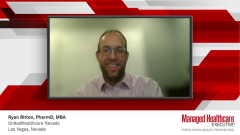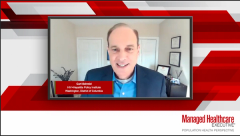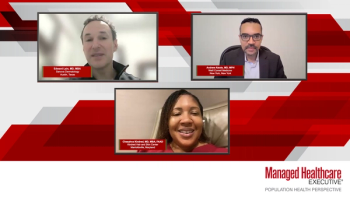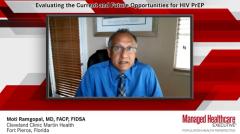
Population Health and HIV PrEP
Payer perspective regarding strategies that can be deployed to help improve the patient/provider experience and utilization of PrEP therapy as prophylaxis against HIV.
Episodes in this series

Douglas Krakower, MD: In terms of trying to meet the quadruple aim for the [Institute for Healthcare Improvement], there are a lot of ways we could work on improving both patient experience and outcome, and clinician experiences, satisfaction and outcome. I think we need to acknowledge that PrEP [pre-exposure prophylaxis] right now is relatively complicated from the perspective of the medical aspects. There’s a fair bit of follow-up. For example, right now, for people taking oral PrEP based on the CDC guidelines, which actually were just updated last week, the idea is to have someone come in quarterly for their adherence and medication and testing. That’s really important from a safety standpoint, but it is burdensome to both patients and providers. I think we need to think about ways to safely de-medicalize PrEP to some degree so that it’s more accessible. We’re meeting patients where they are, because people have busy lives and they may be otherwise completely healthy, and so we don’t want overburden them such that they don’t opt to continue with PrEP or initiate it in the first place.
Same thing on the clinician side. I think we need to figure out ways to give clinicians tools to make HIV testing, PrEP conversations, prescribing, and follow-up much easier on them and their staff. This could be offloading busy clinicians with other health care professionals who can do a lot of the work with clients and patients to make the burden on the clinician who’s prescribing it a little less. We can think about ways to use the electronic health record and automated tools to help remind clinicians about patients who may be at increased risk for HIV acquisition based on their electronic health record history. For example, if they’ve had past sexually transmitted infections, then that would be a way to prompt them to think about talking about PrEP.
In terms of follow-up, if you have people in large numbers on PrEP in a clinician’s panel, we really need population health management tools, whether that’s personnel, where they can offload with a nurse, medical assistant or other professional who can work on managing people’s follow-up after the initial prescription and making sure that they have what they need in terms of laboratory care, adherence counseling, and getting their questions answered. That can really make a good impact on the quadruple aim of everyone’s experience and outcomes.
I think we need to think about innovative ways to get PrEP to people where they are that include giving it completely out of the health care system. That’s already underway with the idea of telemedicine for PrEP, or tele-PrEP, where you can have people at any jurisdiction in the country accessing PrEP centrally with virtual visits, having home-based lab testing, or maybe local testing, but it avoids having to take a day off of work for example, and come into the clinic 4 times a year. There are a lot of ways to innovate and improve the goals of the quadruple aim from the [Institute for Healthcare Improvement].
There are a number of population health challenges in terms of people who might be eligible for PrEP or on it. The first is raising awareness of PrEP, particularly in communities where there have been high rates of new HIV infections, such as the southeastern United States, and where PrEP use has been lower than other regions, and particularly among Black and Latinx populations. I think some of these challenges can be met by well-designed public health campaigns where people are made aware of PrEP in a broad community-wide sense. I think there have been some misconceptions that PrEP is just for certain populations. We’ve heard from research we’ve done that cisgender women have heard that PrEP is just for gay men, for example, and we know that’s not true at all. In fact, PrEP is underused among cisgender women. We need to think about ways to inform the public that this is something that’s a benefit to them so that they can access it.
I think we also need to make the access easier instead of asking people to exclusively come into health care settings where some people are otherwise healthy and don’t see a health care provider regularly. Other people may have faced stigma and discrimination or judgments by health care providers in terms of sexual health care. People may not want to see clinicians for things like PrEP. So if we can think about creative ways to use community-based organizations to implement PrEP in the future, I think those would be ways to improve access more broadly on a population level.
Once people are using PrEP and they are engaged, I think accessing paraprofessionals who are not necessarily the prescribing clinician for PrEP can also improve the number of people we can support on PrEP. For example, at the hospital where I work, there’s a pharmacist who has been really motivated to work on the PrEP-using population in the primary care clinic. It’s a very busy, big primary care clinic, and there are a number of primary care providers who prescribe PrEP to their patients. But having the pharmacist as a central person who has expertise, maybe a bit more time to manage the group, and also using the electronic health record to keep track of people, these are ways where you can really scale up on a population level without overburdening the clients or the health care professionals who are managing the PrEP.
Thinking about ways to use telemedicine for PrEP is a really creative way to do this as well for people who are in rural areas, or frankly, people who just prefer to do things virtually. The COVID-19 pandemic has given people opportunities to try new ways of accessing and using health care. While I don’t think that the whole world is going to be virtual in terms of health care, for the indefinite future, there’s no question that there are certain people and aspects of health care that can be done more efficiently and more effectively using full telemedicine or maybe a combination-hybrid model. PrEP, I think, is a really good way to do that.
There are already academic, public health, and private organizations that have robust tele-PrEP programs that have been going for several years now. These haven’t been as rigorously studied yet as I would like to know the outcomes, but my sense from talking to people who have engaged in them is that these are excellent opportunities to expand PrEP on a population level to more people. Colleagues of mine here in Boston are doing studies with colleagues in the South to see if a tele-PrEP model keeps people engaged and adherent to PrEP compared to a standard in-person model. Over the next few years, we’ll learn a lot more about some of these innovative approaches to delivering PrEP as well.
In terms of programs that can help make PrEP more effective for patients and for providers in the health care system, I think having a team-based approach is an excellent way to approach PrEP. There’s the prescribing clinician, but engaging nurses, pharmacists, medical assistants, a whole series of people on the team who may have different levels of expertise and different amounts of time.
For example, in terms of adherence counseling, research has shown that using behavioral cognitive methodologies can be really effective to help people problem-solve with their adherence, but a primary care clinician with a huge panel of patients may not have time to do that. This involves engaging nurses who can be trained in some of these methods, or behavioral health specialists, and even peer navigators who can talk at the level of a peer with someone using PrEP about their experiences and the way they’ve overcome challenges to accessing PrEP, integrating into their lives, some of the social considerations of using PrEP in terms of disclosing to partners, peers, and family. I see the future and the present, frankly, is using a team-based approach.
At one of the places where I work, we have an excellent nurse who basically manages the PrEP program except for the actual prescribing and refilling, and does an excellent job. This person has gained all the expertise as being a specialist as an infectious diseases nurse, and so the jump to PrEP is really quite straightforward. She’s able to manage many more patient cases than I could alone. Using team-based approaches and integrating those with technological tools, such as using population health management tools from the electronic health record, are ways you can scale this up most effectively. I think those have been helpful for me personally at our institution. I know that I’m not always in the clinic. I do some research as well as clinical care, and even the busiest clinicians have been pulled in so many directions with all that they’re asked to do, so we need to be offloading and working in teams to make sure this is scalable and sustainable.
Ryan Bitton, PharmD, MBA: The utilization management strategies for PrEP have changed over the years. Initially, some plans had prior authorization, some plans didn’t. They are to the point where there’s not a lot of prior authorization; PrEP is a pretty standard of care recommendation. There’s really not utilization management on some of the therapies. Things like generic Truvada are available without prior authorization with a $0 co-pay, I’m assuming for most plans, including ours. There are obviously multiple therapies out there. Some of the other therapies may have prior authorization and requirements around a generic-Truvada-first type of policy. If generic Truvada doesn’t work, which I don’t know if we see failure in this population, Truvada failing may not be the issue, but contraindication or intolerance or reasons why you wouldn’t want to use generic Truvada, there are allowances to get into other therapies.
Transcript edited for clarity.
Newsletter
Get the latest industry news, event updates, and more from Managed healthcare Executive.

